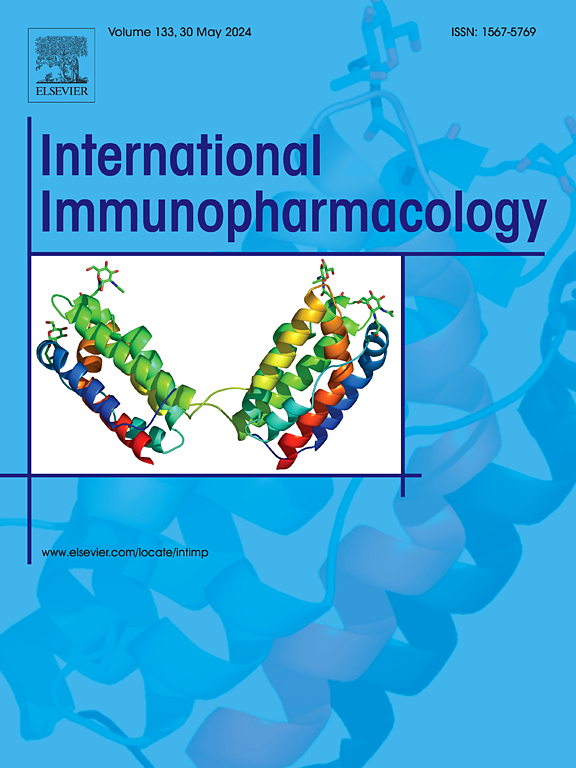钙网蛋白驱动的免疫原性细胞死亡通过LRP1/Rac1信号传导促进破骨细胞分化和骨关节炎进展
IF 4.7
2区 医学
Q2 IMMUNOLOGY
引用次数: 0
摘要
软骨下骨破骨细胞异常活化是骨关节炎(OA)的标志。本研究发现calreticulin (CALR)是一种关键的免疫原性细胞死亡(ICD)标志物,是破骨细胞分化和OA发病机制的关键调节因子。蛋白质组学分析显示,骨性关节炎患者软骨下骨中CALR表达升高,这在人类标本和内侧半月板(DMM)诱导的小鼠骨性关节炎模型中得到进一步验证。体外实验表明,破骨细胞分化过程中CALR的上调激活了低密度脂蛋白受体相关蛋白1 (LRP1)/ ras相关C3肉毒毒素底物1 (Rac1)信号通路,促进破骨细胞发生和骨吸收。这些作用被细胞凋亡抑制剂zad -fmk或CALR敲低所抑制。calr缺陷小鼠在dmm后表现出软骨下骨损伤减轻和OA进展延迟。在机制上,CALR通过LRP1/ rac1介导的活化t细胞核因子胞质1 (NFATc1)的激活和骨吸收因子(基质金属蛋白酶-9 (MMP-9)、组织蛋白酶K (CTSK))的分泌来调控破骨细胞的功能。我们的研究确定CALR是OA的一个新的治疗靶点,将ICD与破骨细胞驱动的软骨下骨吸收和微结构破坏连接起来。本文章由计算机程序翻译,如有差异,请以英文原文为准。

Calreticulin-driven immunogenic cell death promotes osteoclast differentiation and osteoarthritis progression via the LRP1/Rac1 signaling
Aberrant osteoclast activation in subchondral bone is a hallmark of osteoarthritis (OA). This study identifies calreticulin (CALR), a key immunogenic cell death (ICD) marker, as a critical regulator of osteoclast differentiation and OA pathogenesis. Proteomic analysis revealed elevated CALR expression in subchondral bone from OA patients, which was further validated in human specimens and a destabilization of the medial meniscus (DMM)-induced murine OA model. In vitro, CALR upregulation during osteoclast differentiation activated the low-density lipoprotein receptor-related protein 1 (LRP1)/Ras-related C3 botulinum toxin substrate 1 (Rac1) signaling pathway, promoting osteoclastogenesis and bone resorption. These effects were suppressed by the apoptosis inhibitor zVAD-fmk or CALR knockdown. CALR-deficient mice exhibited attenuated subchondral bone damage and delayed OA progression post-DMM. Mechanistically, CALR governs osteoclast function via LRP1/Rac1-mediated nuclear factor of activated T-cells cytoplasmic 1 (NFATc1) activation and secretion of bone-resorbing factors (matrix metalloproteinase-9 (MMP-9), cathepsin K (CTSK)). Our study establishes CALR as a novel therapeutic target for OA, bridging ICD to osteoclast-driven subchondral bone resorption and microarchitectural disruption.
求助全文
通过发布文献求助,成功后即可免费获取论文全文。
去求助
来源期刊
CiteScore
8.40
自引率
3.60%
发文量
935
审稿时长
53 days
期刊介绍:
International Immunopharmacology is the primary vehicle for the publication of original research papers pertinent to the overlapping areas of immunology, pharmacology, cytokine biology, immunotherapy, immunopathology and immunotoxicology. Review articles that encompass these subjects are also welcome.
The subject material appropriate for submission includes:
• Clinical studies employing immunotherapy of any type including the use of: bacterial and chemical agents; thymic hormones, interferon, lymphokines, etc., in transplantation and diseases such as cancer, immunodeficiency, chronic infection and allergic, inflammatory or autoimmune disorders.
• Studies on the mechanisms of action of these agents for specific parameters of immune competence as well as the overall clinical state.
• Pre-clinical animal studies and in vitro studies on mechanisms of action with immunopotentiators, immunomodulators, immunoadjuvants and other pharmacological agents active on cells participating in immune or allergic responses.
• Pharmacological compounds, microbial products and toxicological agents that affect the lymphoid system, and their mechanisms of action.
• Agents that activate genes or modify transcription and translation within the immune response.
• Substances activated, generated, or released through immunologic or related pathways that are pharmacologically active.
• Production, function and regulation of cytokines and their receptors.
• Classical pharmacological studies on the effects of chemokines and bioactive factors released during immunological reactions.

 求助内容:
求助内容: 应助结果提醒方式:
应助结果提醒方式:


